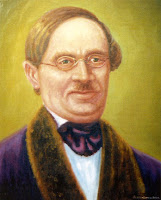Located in Group 5 and Period 6 is one of the element used to be alloyed with Platinum or Palladium to be made into Medical Instruments. This is Ruthenium.
 |
| Medical Instruments |
First Discovered in 1844 by a Russian Chemist called Karl Karlovich Klaus and first isolated by Jędrzej Śniadecki in 1808.
 |
| Jędrzej Śniadecki |
You can actually see the discovery date is later than the isolation date. Here is why :
Actually, the credit of discovery was supposed to be given to Jędrzej Śniadecki. However, after he isolated the element and published his work, the other scientists couldn't produce this new element. So, the publishing works of Jędrzej Śniadecki was thought to be fudged. He never research this element again.
After 20 years ( 1828 ), a Swedish Chemist and Russian Chemist called Jöns Jacob Berzelius and Gottfried W. Osann respectively both went to research this element. Once again, they published this work and let the other chemists to authenticate. Of course, the other scientist once again, couldn't produce this new element. So, again, the works of Gottfried W. Osann and Jöns Jacob Berzelius was believed to be fudged. Gottfried and Jacob never research this element again.
 |
| Karl Karlovich Klaus |
It wasn't until 1844 when Karl Karlovich Klaus finally announced the discovery of this new element. Karl found a posititive proof that Ruthenium can actually be founded in a sample of Platinum Ores from the Ural Mountains.. He published his works to let the other scientists authenticate. To his luck, the other scientist finally successfully isolated Ruthenium, Therefore, because of this, Karl was officially announced as an official discoverer of Ruthenium.
 |
| Pyroxinite |
Ruthenium can be founded in Platinum - containing ores in the Ural Mountains and in North and South America. Ruthenium can also be found in Pyroxenite ores in South Africa too.
Ruthenium is the 74th most abundant element in the Earth's crust. You can found 100 parts per million of Ruthenium in the Earth's Crust. You can only found Ruthenium in minerals such as Pentlandite and also Pyroxinite.
Atomic Mass : 44
Name : Ruthenium
Latin Name : Ruthenia
Electrons per Shell : [ 2, 8, 18, 13, 1 ]
Discoverer : Karl Karlovich Klaus ( 1844 )
Isolator : Jędrzej Śniadecki ( 1808 )
Element's : Atomic Mass : 101.07 u
: Density : 12g/cm3
: Type : Transition Metals
Chemical Properties :
 |
| Ruthenium - 101 |
- reacts with Fluorine
- doesn't dissolve in acids
- doesn't react with oxygen in room temperatures
- reacts with oxygen in higher temperatures
- 42 isotopes : 3 of them are :
Ruthenium - 99 : Protons : 44
: Neutrons : 55
: Electrons : 44
( Half Life : Stable )
Ruthenium - 100 : Protons : 44
: Neutrons : 56
: Electrons : 44
( Half Life : Stable )
Ruthenium - 101 : Protons : 44
: Neutrons : 57
: Electrons : 44
( Half Life : Stable )
Physical Properties :
- hard
- silvery - white colored
- shiny surface
- Melting Point : 2334 degrees Celsius ( 4233.3 Fahrenheit )
- Boiling Point : 4150 degrees Celsius ( 7502 Fahrenheit )
How Ruthenium got its name?
Ruthenium got its name from its discovery country's name in Latin : Ruthenia, meaning the country Russia.
 |
| Russia Flag |
Uses
 |
| Ruthenium Jewelries |
Ruthenium is used as alloying with Platinum or Palladium to prevent corrosion of oxygen as well as to increase the strength of the material. These alloys are often used in making devices for measuring extremely high and low temperatures, medical instruments and electrical contacts.
Ruthenium is also used to make jewelries. However, jewelries made of Ruthenium are often expensive, so not much jewelries are made of Ruthenium.
THIS IS THE END OF RUTHENIUM
To go to homepage, click this link :
Our Homepage
To go to Chemistry Element page, click this link :
garnetchemistryelement.blogspot.com
To go to homepage, click this link :
Our Homepage
To go to Chemistry Element page, click this link :
garnetchemistryelement.blogspot.com
Thanks for visiting.
If there is any improvements needed, feel free to comment at the comment section below.
Thank you.
Thank you.


No comments:
Post a Comment